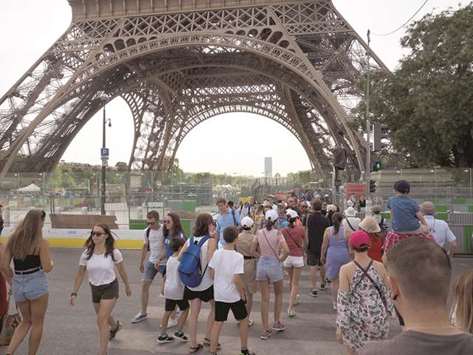The Puteaux outdoor swimming pool, on an island in the middle of the Seine in Paris, beckons like an oasis, offering cool water to splash around in against the backdrop of the French capital. But it might as well be a mirage for Aurore and her son Tristan, who aren’t allowed in: The municipal swimming pool is reserved only for community residents and membership holders.
Outsiders aren’t even allowed to enter the car park, waved off regardless of whether they’re from Paris, Lille or Marseille. “We are a victim of our success,” says an admissions office employee. ‘No entry’ is a phrase that’s become increasingly common at popular spots across Europe.
Puteaux, the district of Paris where the swimming pool is located, says the restrictions were put in place for security reasons. Admission was limited to 800 people after visitors had to reckon with long lines, skirmishes and damage to the swimming pool.
The ‘resident rule’ was first put in place for the 2017 season but didn’t cause any problems until the unusually hot 2018 summer season. The pool is not the only place in Paris that has been struggling to curb visitor numbers. The Eiffel Tower, with more than 6 million visitors annually, started selling more of its tickets online in 2018 in order to reduce long waiting times. However, employees at the popular attraction were dissatisfied with the new system and held strikes, shutting down the tower as thousands of tourists looked on with disappointment.
Spain has similar problems. The number of visitors allowed to one especially spectacular beach in the north of the country has been limited for the last four years. In order to see the famous Playa de Las Catedrales in Galicia between July and September, visitors must first acquire a personal and non-transferrable special permit. The beach, featuring impressive rock formations, was declared a Biosphere Reserve in 2007, and only limited numbers of people are allowed access to it.
In Italy, discussions about restrictions on certain attractions are ongoing, for example in Venice. But even though there is talk of turnstiles, barriers and the like, attractions in the lagoon city, such as the Piazza San Marco, have until now never been closed off due to too many people. Yet people aren’t allowed to go everywhere they want in Bella Italia. Vehicles and motorcycles are allowed only in limited numbers in the area around the Sella Pass, an Alpine pass in the Dolomites, in order to better protect the environment.
And tourists need to have a ticket in order to walk the path between the picturesque villages of Cinque Terre in Linguaria. Things aren’t necessarily better as one goes north, either: The Dutch tourist hotspot Amsterdam has taken drastic measures against too many people.
On especially full evenings in the red-light district near the train station, there are plans in the works to briefly shut down and clear entire streets of people in order to clean them up. Longer closures of streets are also possible. The reason for the intervention? As Amsterdam’s ombudsman says, the city turns into a ‘jungle’ at night.
And while no one would speak of a ‘jungle’ during Munich’s famous Oktoberfest, the tents are often so full to bursting with thousands of tourists that organisers block entrances and hang up signs warning that tents are closed due to overcrowding.
Such blockages are common even after the popular opening day of a festival that takes place in October annually. Trying to leave the tent for a breath of fresh air and then return without a reservation is nearly impossible: Phrases like ‘My friends are waiting’ or ‘My jacket is inside’ have no effect on the bouncers,who are long used to such tactics.– DPA

PROTESTS: Staff at the Eiffel Tower in Paris went on strike in 2018 in protest at a new ticketing system that was causing massive queues.


